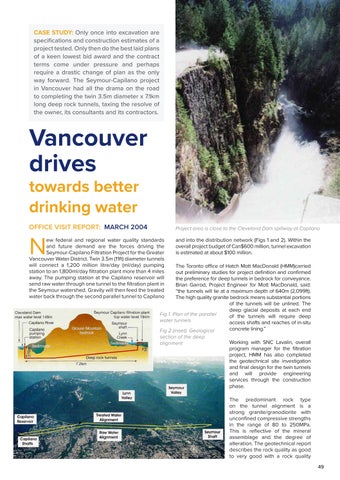CASE STUDY: Only once into excavation are specifications and construction estimates of a project tested. Only then do the best laid plans of a keen lowest bid award and the contract terms come under pressure and perhaps require a drastic change of plan as the only way forward. The Seymour-Capilano project in Vancouver had all the drama on the road to completing the twin 3.5m diameter x 7.1km long deep rock tunnels, taxing the resolve of the owner, its consultants and its contractors.
Vancouver drives towards better drinking water
OFFICE VISIT REPORT: MARCH 2004
N
Project area is close to the Cleveland Dam spillway at Capilano
ew federal and regional water quality standards and future demand are the forces driving the Seymour-Capilano Filtration Project for the Greater Vancouver Water District. Twin 3.5m (11ft) diameter tunnels will connect a 1,200 million litre/day (ml/day) pumping station to an 1,800ml/day filtration plant more than 4 miles away. The pumping station at the Capilano reservoir will send raw water through one tunnel to the filtration plant in the Seymour watershed. Gravity will then feed the treated water back through the second parallel tunnel to Capilano
and into the distribution network (Figs 1 and 2). Within the overall project budget of Can$600 million, tunnel excavation is estimated at about $100 million.
The Toronto office of Hatch Mott MacDonald (HMM)carried out preliminary studies for project definition and confirmed the preference for deep tunnels in bedrock for conveyance. Brian Garrod, Project Engineer for Mott MacDonald, said: “the tunnels will lie at a maximum depth of 640m (2,099ft). The high quality granite bedrock means substantial portions of the tunnels will be unlined. The deep glacial deposits at each end Fig 1. Plan of the parallel of the tunnels will require deep water tunnels access shafts and reaches of in-situ concrete lining.” Fig 2 (inset). Geological section of the deep alignment
Working with SNC Lavalin, overall program manager for the filtration project, HMM has also completed the geotechnical site investigation and final design for the twin tunnels and will provide engineering services through the construction phase. The predominant rock type on the tunnel alignment is a strong granite/granodiorite with unconfined compressive strengths in the range of 80 to 250MPa. This is reflective of the mineral assemblage and the degree of alteration. The geotechnical report describes the rock quality as good to very good with a rock quality 49






